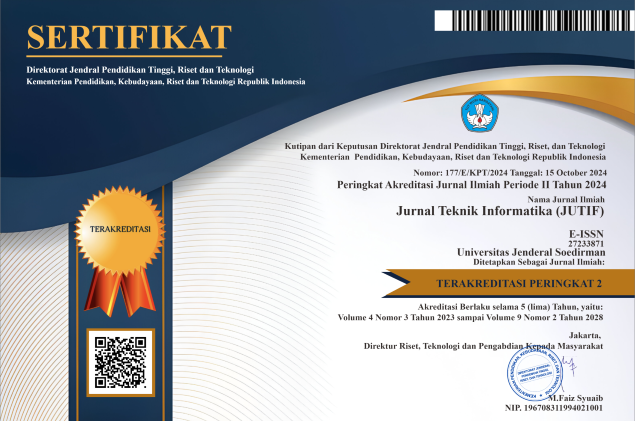A TOPIC-BASED APPROACH FOR RECOMMENDING UNDERGRADUATE THESIS SUPERVISOR USING LDA WITH COSINE SIMILARITY
DOI:
https://doi.org/10.52436/1.jutif.2025.6.1.4061Keywords:
Google Scholar, Latent Dirichlet Allocation, ResearchGate, Thesis advisor, Topic modelingAbstract
The thesis is one of the critical factors in determining student graduation. While working on the thesis, students will be guided by a lecturer who has the role and responsibility to ensure that students can prepare the thesis well so that the thesis is ready to be tested and is of good quality. Therefore, selecting a supervisor with the same expertise as the thesis topic is essential in determining students' success in completing their thesis. So far, the selection of thesis supervisors at Dian Nuswantoro University still needs to be done manually by students, so the lack of information about the supervisor can hinder students in determining the supervisor. This study aims to model the topic of lecturer research publications taken from the ResearchGate and Google Scholar platforms so that it is easier for students to choose a thesis supervisor whose research topic is relevant to the student's thesis using the Latent Dirichlet Allocation method. The LDA method will mark each word in the topic in a semi-random distribution. It will calculate the probability of the topic in the dataset and the likelihood of the word against the topic for each iteration. The results of LDA modeling present six main topics of lecturer research with the highest coherence score of 0.764, and then the resulting topics and thesis titles will be compared using cosine similarity. Students can use The highest cosine value as a reference when determining the right thesis topic. Thus, the supervisor selection process will be more focused and in accordance with the student's research interests.
Downloads
References
M. C. Wijanto, R. Rachmadiany, and O. Karnalim, “Thesis Supervisor Recommendation with Representative Content and Information Retrieval,” Journal of Information Systems Engineering and Business Intelligence, vol. 6, no. 2, 2020, doi: 10.20473/jisebi.6.2.143-150.
A. A. B. Arisetiawan, Indriati, and D. E. Ratnawati, “Sistem Rekomendasi Dosen Pembimbing Berdasarkan Dokumen Judul Skripsi di Bidang Komputasi Cerdas Menggunakan Metode BM25,” Jurnal Pengembangan Teknologi Informasi dan Ilmu Komputer, vol. 3, no. 6, 2019.
Anis Budiono and Sri Eniyati, “Sistem Rekomendasi Dosen Pembimbing Tugas Akhir Menggunakan Content Based Filtering,” Jurnal Elektronika Dan Komputer, vol. 16, no. 1, 2023.
R. Rismanto, A. R. Syulistyo, and B. P. C. Agusta, “Research supervisor recommendation system based on topic conformity,” International Journal of Modern Education and Computer Science, vol. 12, no. 1, 2020, doi: 10.5815/ijmecs.2020.01.04.
A. Nurlayli and Moch. A. Nasichuddin, “TOPIK MODELING PENELITIAN DOSEN JPTEI UNY PADA GOOGLE SCHOLAR MENGGUNAKAN LATENT DIRICHLET ALLOCATION,” Elinvo (Electronics, Informatics, and Vocational Education), vol. 4, no. 2, 2019, doi: 10.21831/elinvo.v4i2.28254.
F. T. Anggraeny, I. Y. Purbasari, and E. F. Wulandari, “Undergraduate Thesis Supervisor Recommendation Based On Text Similarity,” Darmajaya, 2019.
H. Jelodar et al., “Latent Dirichlet allocation (LDA) and topic modeling: models, applications, a survey,” Multimed Tools Appl, vol. 78, no. 11, 2019, doi: 10.1007/s11042-018-6894-4.
L. George and P. Sumathy, “An integrated clustering and BERT framework for improved topic modeling,” International Journal of Information Technology (Singapore), vol. 15, no. 4, 2023, doi: 10.1007/s41870-023-01268-w.
I. Vayansky and S. A. P. Kumar, “A review of topic modeling methods,” Inf Syst, vol. 94, 2020, doi: 10.1016/j.is.2020.101582.
D. Maulidiya, “Topic Modelling using Latent Dirichlet Allocation (LDA) to Investigate the Latent Topics of Mathematical Creative Thinking Research in Indonesia,” Journal of Intelligent Computing & Health Informatics, vol. 3, no. 2, 2023, doi: 10.26714/jichi.v3i2.11428.
E. S. Negara and D. Triadi, “Topic modeling using latent dirichlet allocation (LDA) on twitter data with Indonesia keyword,” Bulletin of Social Informatics Theory and Application, vol. 5, no. 2, 2022, doi: 10.31763/businta.v5i2.455.
S. Karmila and V. I. Ardianti, “METODE LATENT DIRICHLET ALLOCATION UNTUK MENENTUKAN TOPIK TEKS SUATU BERITA,” Jurnal Informatika dan Komputasi: Media Bahasan, Analisa dan Aplikasi, vol. 16, no. 01, 2022, doi: 10.56956/jiki.v16i01.100.
H. Hairani and M. Mujahid, “Recommendations of Thesis Supervisor using the Cosine Similarity Method,” SISTEMASI, vol. 11, no. 3, 2022, doi: 10.32520/stmsi.v11i3.2003.
S. Dami and F. Madadi, “Recommender System Using LDA Topic Modeling Approach,” SSRN Electronic Journal, 2022, doi: 10.2139/ssrn.4173345.
S. A. Nugroho, F. A. Bachtiar, and R. C. Wihandika, “ASPECT EXTRACTION IN E-COMMERCE USING LATENT DIRICHLET ALLOCATION (LDA) WITH TERM FREQUENCY-INVERSE DOCUMENT FREQUENCY (TF-IDF),” Jurnal Ilmiah Kursor, vol. 11, no. 2, 2022, doi: 10.21107/kursor.v11i2.247.
S. H. Mohammed and S. Al-Augby, “LSA & LDA topic modeling classification: Comparison study on E-books,” Indonesian Journal of Electrical Engineering and Computer Science, vol. 19, no. 1, 2020, doi: 10.11591/ijeecs.v19.i1.pp353-362.
Y. Matira and I. Setiawan, “Pemodelan Topik pada Judul Berita Online Detikcom Menggunakan Latent Dirichlet Allocation,” Estimasi: Journal of Statistics and Its Application, vol. 4, no. 1, 2023.
O. Kononova, T. He, H. Huo, A. Trewartha, E. A. Olivetti, and G. Ceder, “Opportunities and challenges of text mining in aterials research,” 2021. doi: 10.1016/j.isci.2021.102155.
D. L. C. Pardede and M. A. I. Waskita, “ANALISIS PEMODELAN TOPIK UNTUK ULASAN TENTANG PEDULI LINDUNGI,” Jurnal Ilmiah Informatika Komputer, vol. 28, no. 1, 2023, doi: 10.35760/ik.2023.v28i1.7925.
D. R. Sari, Y. Yusra, M. Fikry, F. Yanto, and F. Insani, “Klasifikasi Sentimen Masyarakat di Twitter Terhadap Ancaman Resesi Ekonomi 2023 dengan Metode Naïve Bayes Classifier,” Jurnal Sistem Komputer dan Informatika (JSON), vol. 4, no. 4, 2023, doi: 10.30865/json.v4i4.6276.
M. R. Fahlevvi and A. SN, “Topic Modeling on Online News.Portal Using Latent Dirichlet Allocation (LDA),” IJCCS (Indonesian Journal of Computing and Cybernetics Systems), vol. 16, no. 4, 2022, doi: 10.22146/ijccs.74383.
N. Novarian, S. Khomsah, and A. B. Arifa, “Topic Modeling Tugas Akhir Mahasiswa Fakultas Informatika Institut Teknologi Telkom Purwokerto Menggunakan Metode Latent Dirichlet Allocation,” LEDGER: Journal Informatic and Information Technology , vol. 2, no. 1, 2023.
K. Tri Putra, M. Amin Hariyadi, and C. Crysdian, “PERBANDINGAN FEATURE EXTRACTION TF-IDF DAN BOW UNTUK ANALISIS SENTIMEN BERBASIS SVM,” Jurnal Cahaya MAndalika, 2023.
S. Zhou, P. Kan, Q. Huang, and J. Silbernagel, “A guided latent Dirichlet allocation approach to investigate real-time latent topics of Twitter data during Hurricane Laura,” J Inf Sci, vol. 49, no. 2, 2023, doi: 10.1177/01655515211007724.
R. P. Fauzie Afidh and Z. A. Hasibuan, “Indonesia’s News Topic Discussion about Covid-19 Outbreak using Latent Dirichlet Allocation,” in 2020 5th International Conference on Informatics and Computing, ICIC 2020, 2020. doi: 10.1109/ICIC50835.2020.9288596.
V. Alpiana, A. Salam, F. Alzami, I. Rizqa, and D. Aqmala, “Analisis Topic-Modelling Menggunakan Latent Dirichlet Allocation (LDA) Pada Ulasan Sosial Media Youtube,” JURNAL MEDIA INFORMATIKA BUDIDARMA, vol. 8, no. 1, 2024, doi: 10.30865/mib.v8i1.7127.
R. P. F. Afidh and Syahrial, “Pemodelan Topik Menggunakan n-Gram dan Non-negative Matrix Factorization,” Jurnal Informasi dan Teknologi, 2023, doi: 10.60083/jidt.v5i1.385.
A. I. Alfanzar, K. Khalid, and I. S. Rozas, “TOPIC MODELLING SKRIPSI MENGGUNAKAN METODE LATENT DIRICLHET ALLOCATION,” JSiI (Jurnal Sistem Informasi), vol. 7, no. 1, 2020, doi: 10.30656/jsii.v7i1.2036.
O. B. Sezer and A. M. Ozbayoglu, “Financial trading model with stock bar chart image time series with deep convolutional neural networks,” Intelligent Automation and Soft Computing, vol. 26, no. 2, 2020, doi: 10.31209/2018.100000065.
H. Oktafiandi, “Implementasi LDA untuk Pengelompokan Topik Twitter Bertagar# Mypertamina,” Jurnal Ekonomi dan Teknik Informatika, vol. 11, no. 1, 2023.
C. Naury, D. H. Fudholi, and A. F. Hidayatullah, “Topic Modelling pada Sentimen Terhadap Headline Berita Online Berbahasa Indonesia Menggunakan LDA dan LSTM,” JURNAL MEDIA INFORMATIKA BUDIDARMA, vol. 5, no. 1, 2021, doi: 10.30865/mib.v5i1.2556.
A. Gottfried, C. Hartmann, and D. Yates, “Mining open government data for business intelligence using data visualization: A two-industry case study,” Journal of Theoretical and Applied Electronic Commerce Research, vol. 16, no. 4, 2021, doi: 10.3390/JTAER16040059.
T. Titiana and D. H. Bangkalang, “ANALISIS DAN PENERAPAN TOPIC MODELING PADA JUDUL TUGAS AKHIR MAHASISWA MENGGUNAKAN METODE LATENT DIRICHLET ALLOCATION (LDA),” JIPI (Jurnal Ilmiah Penelitian dan Pembelajaran Informatika), vol. 8, no. 4, 2023, doi: 10.29100/jipi.v8i4.4254.
R. Widayanti, M. H. R. Chakim, C. Lukita, U. Rahardja, and N. Lutfiani, “Improving Recommender Systems using Hybrid Techniques of Collaborative Filtering and Content-Based Filtering,” Journal of Applied Data Sciences, vol. 4, no. 3, 2023, doi: 10.47738/jads.v4i3.115.


























